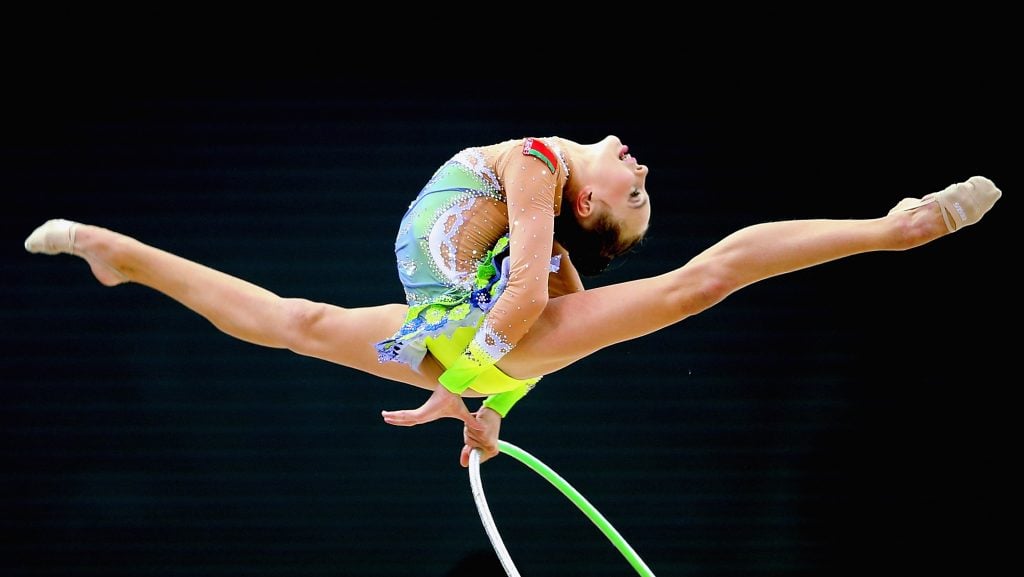It is an absolute candy for the eyes, rhythmic gymnastics involves all sorts of movements, contortions and colors thanks to the atheletes dedicated to the sport. Rhythmic gymnastics is a sport where the athletes perform on the flow with some form of apparatus such as a ball, hoop, ribbon, rope, or club. It combines the elements of dance, gymnastics and calisthenics.
The gymnasts must be extremely strong, flexible and agile in order to excel. This sport is governed by the International Gymnastics Federation (FIG) and was first recognized as a sport in 1963. Rhythmic gymnastics was first featured in the Olympics in 1996. At the international level, it is a women-only sport. The gymnasts are judged based on their execution skills, their artistry and how difficult their skills are. For this last component, they tend to gain more points.
The athletes must perform balances, leaps, pivots, and flexible movements, plus tossing, rolling, catching and other ways of manipulating their apparatus. In this review, we try to understand this sport by looking into how it was created and performed in the past. We also breakdown the historical evolution of the sport that we know as rhythmic gymnastics today. The sport's history is almost as complex as the moves athletes wow us with out on the floor.

Image Source: en.wikipedia.org
How Old Is Rhythmic Gymnastics?
It started in Ancient Egypt, and the ancient Egyptians were the earliest Rhythmic Gymnasts. Artifacts have in fact shown that women with spheres worked in group exercises just as the modern gymnasts do today. However, the events were much more recreational than competitive. While not all historians agreed on the exact time rhythmic gymnastics started, everyone agrees that the ancient Egyptians shaped it into how it is today.
When Was It Recognized As An Official Sport?
This sport, despite its existence for many years, the International Gymnastics Federation (FIG) did not recognize it until 1962. The first World Championships of Rhythmic Gymnastics were held in 1963. The first-ever Rhythmic Gymnastics competitions took place in Budapest. At this time, the sport was individual, and no group competitions were allowed until 1996. The Rhythmic Gymnastics world champion at the first Olympics was Ludmila Savinkova who was from the Soviet Union.
What Is Rhythmic Gymnastics' Olympic History
You won’t believe this but Rhythmic Gymnastics was added to the Olympics in 1984 as an Olympic sport. American athletes, however, had been competing in the sport since 1973. When they finally included it in the Olympics, the sport started to emerge from the shadows and became a major Olympic event. In its inaugural year, the gold medal was won by Canada’s Lori Fung. During the 1992 Olympic Games in Barcelona, only one individual was on the program, but in 1996, the Rhythmic Gymnastics teams were added to the program.
Who Made A Big Impact On Rhythmic Gymnastics?
Jean-Georges Noverre (1727-1810)
He was the founder of the classical ballet and helped to develop the concept of using the human body as an expression, which led to the Rhythmic Gymnastics. In the 1800s Rhythmic gymnastics started featuring in competitions as group routines. During the routines, the choreography was designed by him, although this has greatly evolved over time.
Francois A. Delsarte (1811-1871)
He helped to develop the modern dance. He believed that every physical gesture had some sort of spiritual dimension and he also wrote the principles of aesthetic science which is regarded as the rudimentary principle in the science of Rhythmic gymnastics.
Isadora Duncan (1877-1927)
Because Rhythmic Gymnastics is all about the female body, you cannot talk about it without mentioning Isadora Duncan, who is an American Icon in ballerina. She revolutionized dance during her time. Now, while she changed the way people felt about dancing, she also acknowledged all those who came before her. During the 1930s, she experimented with various rhythmic gymnastics routines, and as a result, they started showing up in Europe. Since then it started showing up in many other places and gained plenty of popularity because of her.
Emile-Jacques Dalcroze (1865-1950)
He was a musician who took most of his ideas from the world of dance and music. The institute of Mr. Dalcroze was founded in Geneva and it still teaches rhythmic gymnastics till today. They use the methods he created during his early days. His ideas inspired many generations of rhythmic gymnasts.

The History of Rhythmic Gymnastics Conclusion
The above individuals are some of the people who are directly credited for making rhythmic gymnastics what it is today. This sport has tremendously grown since its inception in ancient Egypt and today, it incorporates ballet that is influenced by Jen-Georges Noverre, and Isadora Duncan. The German System that uses apparatus to work on muscle development is also credited for how rhythmic gymnastics are performed today. This system was influenced by Francois A. Delsarte. The current Rhythmic Gymnastics also pays great tribute to the Swedish method that uses free exercises in order to develop a rhythm.
Currently, there are 12 teams expected to compete during the next Olympic Games. It is a sure sign that Rhythmic Gymnastics has continued to grow steadily. In fact, the time in which the traditional 4 event gymnastics for women was the only thing in the Olympics is far gone. Nowadays, traditional gymnasts and rhythmic gymnasts all have equal but different areas they cover.










